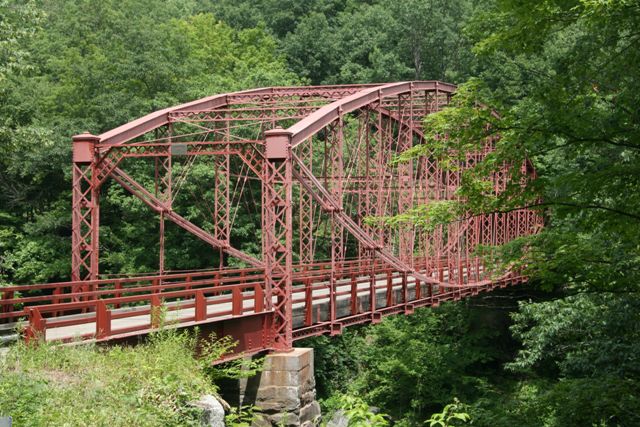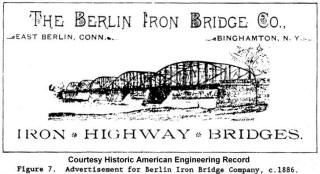We Recommend:
Bach Steel - Experts at historic truss bridge restoration.
BridgeHunter.com Phase 1 is released to the public! - Visit Now
Bardwells Ferry Bridge

Primary Photographer(s): Nathan Holth and Rick McOmber
Bridge Documented: July 13, 2008
Rural: Franklin County, Massachusetts: United States
Metal 13 Panel Pin-Connected Lenticular Through Truss, Fixed and Approach Spans: Metal Stringer (Multi-Beam), Fixed
1882 By Builder/Contractor: Corrugated Metal Company of East Berlin, Connecticut (Berlin Iron Bridge Company of East Berlin, Connecticut)
1995
198.0 Feet (60.4 Meters)
230.0 Feet (70.1 Meters)
14 Feet (4.27 Meters)
1 Main Span(s) and 1 Approach Span(s)
C200170H6MUNNBI

View Information About HSR Ratings
Bridge Documentation
View Archived National Bridge Inventory Report - Has Additional Details and Evaluation
View Historic American Engineering Record (HAER) Documentation For This Bridge
HAER Drawings, PDF - HAER Data Pages, PDF
View The Original 1882 Contract For This Historic Bridge, Courtesy Historic American Engineering Record
View The Original Lenticular Truss Bridge Patent
View Massachusetts Historical Commission (MHC) Inventory Forms For This Historic Bridge
View The National Register of Historic Places Nomination Form For This Historic Bridge

The Bardwell's Ferry Bridge is a beautiful, nationally significant example of the rare lenticular truss bridge type. The bridge has been well maintained and preserved for vehicular traffic, and most importantly, this has been done without altering the original design and thus affecting the high level of historic integrity that this bridge continues to display. For instance, modern crash-tested barriers have been added, properly mounted to the deck so as to protect the bridge's trusses from damage, but at the same time the original and tiny rod railings have been left in place behind these new guardrails. Very few rivets have been replaced with bolts. Original built-up fishtail style floorbeams remain on this bridge. Clearly, despite being maintained for vehicular traffic, this bridge enjoys a high degree of historic integrity. Massachusetts deserves to be thanked for maintaining the structural and historic integrity of this bridge, and hopefully they will continue to do so.
The bridge includes a riveted plate girder approach span. It is possible, however unproven, that there may have been a lenticular pony truss approach span here that was replaced at a later date. Riveted plate girders were not very common on highways in 1882, but were used into the 1920s and 1930s in some states.
Be sure to view the HAER documentation for this bridge as it includes an extensive historical narrative and measured drawings. Engineers will especially enjoy one of the measured drawings which explains how the lenticular truss bridge functions as a unique truss structure. The bridge operates similar to a combination of an arch and cable type of system.
This bridge is nationally significant as a rare surviving example of a lenticular truss bridge, and even among all the lenticular truss bridges an extremely significant bridge. On a statewide basis, the bridge is further significant as the longest remaining lenticular truss span and also the oldest surviving example. Even nationally, this bridge is among the oldest and longest of the lenticular truss bridges. The bridge predates the name change that the Corrugated Metal Company made to the Berlin Iron Bridge Company in 1883 which is why the builder name is listed as Corrugated Metal Company for this 1882 bridge.
![]()
Photo Galleries and Videos: Bardwells Ferry Bridge
Bridge Photo-Documentation
Original / Full Size PhotosA collection of overview and detail photos. This gallery offers photos in the highest available resolution and file size in a touch-friendly popup viewer.
Alternatively, Browse Without Using Viewer
![]()
Bridge Photo-Documentation
Mobile Optimized PhotosA collection of overview and detail photos. This gallery features data-friendly, fast-loading photos in a touch-friendly popup viewer.
Alternatively, Browse Without Using Viewer
![]()
Maps and Links: Bardwells Ferry Bridge
Coordinates (Latitude, Longitude):
Search For Additional Bridge Listings:
Bridgehunter.com: View listed bridges within 0.5 miles (0.8 kilometers) of this bridge.
Bridgehunter.com: View listed bridges within 10 miles (16 kilometers) of this bridge.
Additional Maps:
Google Streetview (If Available)
GeoHack (Additional Links and Coordinates)
Apple Maps (Via DuckDuckGo Search)
Apple Maps (Apple devices only)
Android: Open Location In Your Map or GPS App
Flickr Gallery (Find Nearby Photos)
Wikimedia Commons (Find Nearby Photos)
Directions Via Sygic For Android
Directions Via Sygic For iOS and Android Dolphin Browser
USGS National Map (United States Only)
Historical USGS Topo Maps (United States Only)
Historic Aerials (United States Only)
CalTopo Maps (United States Only)



